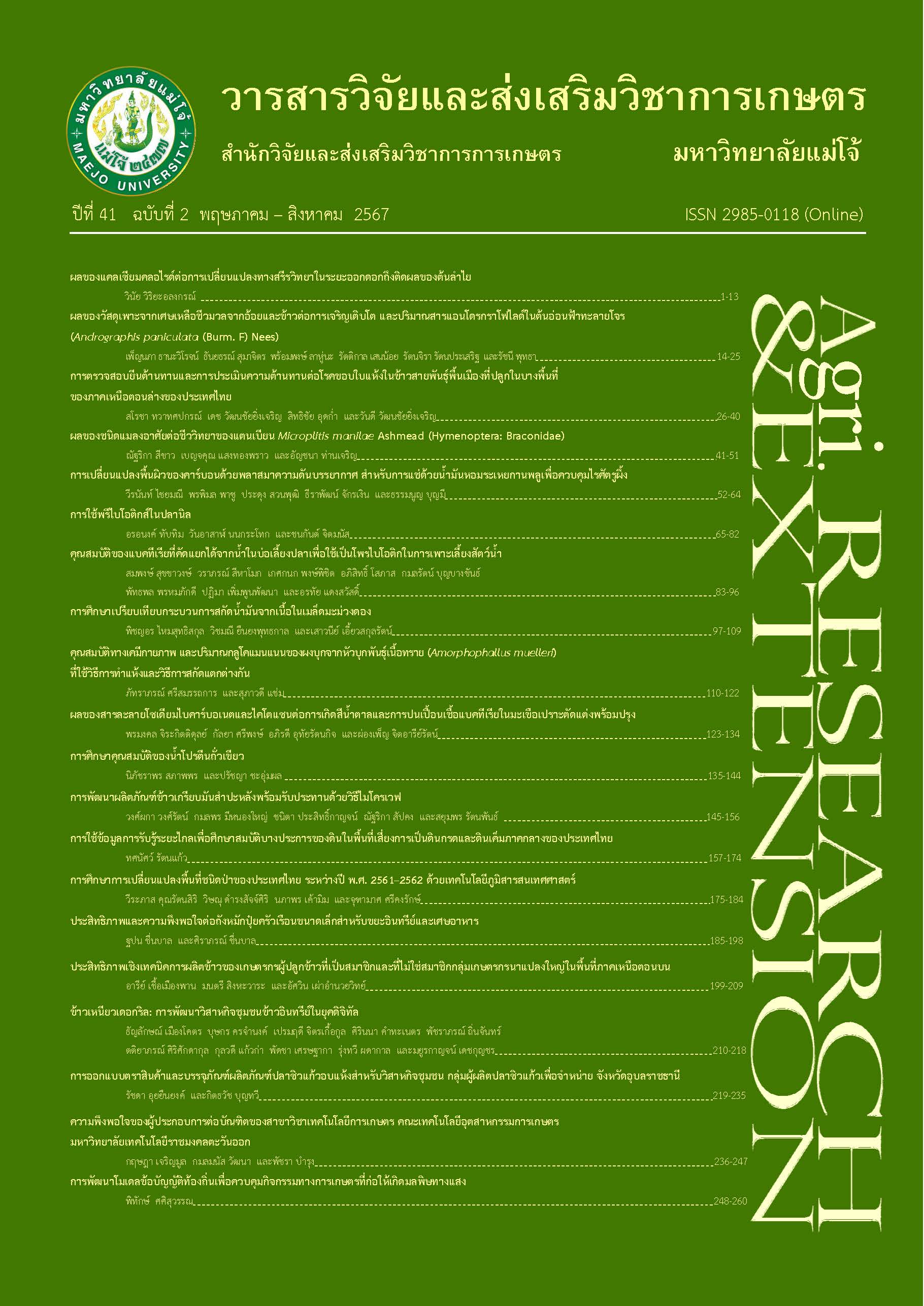Use of Remote Sensing Data for Some Soil Properties Studying in Areas at Risk of Acidic Soil and Saline Soil of Central Thailand
DOI:
https://doi.org/10.14456/jare-mju.2024.33Keywords:
soil property, land use, Sentinel-2, vegetation indexAbstract
Conventional soil properties study including soil sampling and laboratory analysis are laborious, costly and time-consuming. Remote sensing data is collected as reflected electromagnetic radiation that vary with objects and correlate with plant growth and health. It can shorten the time of collecting soil samples, reduce cost from both in filed and laboratory. This research was studied the potential of satellite images (Sentinel 2) by calculating three vegetation indices: Normalized Difference Vegetation Index (NDVI), Green Normalized Difference Vegetation Index (GNDVI) and Normalized Difference Infrared Index (NDII) and correlating with soil fertility indicators, such as soil pH, soil electrical conductivity, and soil organic matter. Soil samples were collected from Kamphaeng Saen district in Nakhon Pathom province, which is at risk of saline soil, as well as from Bang Len district in Nakhon Pathom province and Pak Phli district in Nakhon Nayok province, both of which were at risk of acidic soil. The fertility of the soil was found to be associated with land use types, soil series, and vegetation indices calculated from Sentinel 2 satellite images. In March, the NDVI with a logarithmic model showed the highest potential for estimating soil pH. Similarly, in December, the GNDVI with an exponential model demonstrated the highest potential for estimating soil electrical conductivity. However, all vegetation indices were unsuitable for predicting soil organic matter.
References
Azizan, F.A., I.S. Astuti, M.I. Aditya, T.R. Febbiyanti, A. Williams, A. Young, and A.A. Aziz. 2021. Using multi-temporal satellite data to analyse phenological responses of rubber (Hevea brasiliensis) to climatic variations in South Sumatra, Indonesia. Remote Sensing. [Online]. Available https://www.mdpi.com/2072-4292/13/15/2932 (April 10, 2022).
Cilek, A. and S. Berberoglu. 2018. Object-based crop mapping using multi-temporal Landsat 8 Imagery. Int. Journal of Engineering Research and Application 8(4)(Part-II): 34-37.
Gitelson, A.A., Y.J. Kaufman and M.N. Merzlyak. 1996. Use of a green channel in remote sensing of global vegetation from EOS-MODIS. Remote Sensing of Environment 58(3): 289-298.
Glowienka, E., K. Michalowska, A. Pekala, B. Hejmanowska. 2016. Application of GIS and remote sensing techniques inmultitemporal analyses of soil properties in the Foreland of the Carpathians. IOP Conf. Series: Earth and Environmental Science 44(2016): 052044. [Online]. Available https://iopscience.iop.org/article/10.1088/1755-1315/44/5/052044/pdf (March 18, 2021).
Hunt, E.R. Jr. and B.N. Rock. 1989. Detection of changes in leaf water content using near- and middle-infrared reflectances. Remote Sens. Environ. 30: 43-54. DOI:10.1016/0034-4257(89)90046-1.
Jensen, J.R. 2000. Remote Sensing of Environment: An Earth Resource Perspective Second edition. Upper Saddle River, NJ: Pearson Education, Inc. 592 p.
JI, L., L. ZHANG, B.K. WYLIE and J. ROVER. 2011. On the terminology of the spectral vegetation index (NIR−SWIR)/(NIR+SWIR). International Journal of Remote Sensing 32(21): 6901-6909.
Land Development Department. 2014a. Characteristics and Properties of Soil Series in Central Thailand. Bangkok: Soil Resources Survey and Research Division, Land Development Department, Ministry of Agriculture and Cooperatives. [Online]. Available http://www.ldd.go.th/thaisoils_museum// (January 20, 2023). [in Thai]
Land Development Department. 2014b. Soil and Soil Formation. Bangkok: Soil Resources Survey and Research Division, Land Development Department, Ministry of Agriculture and Cooperatives. [Online]. Available https://www.ldd.go.th/thaisoils_museum/survey_1/soils.htm (January 20, 2023). [in Thai]
Land Development Department. 2016. Characteristics and properties of 62 soil groups. Bangkok: Soil Resources Survey and Research Division, Land Development Department, Ministry of Agriculture and Cooperatives. [Online]. Available http://oss101.ldd.go.th/soilr/product.html (January 20, 2023). [in Thai]
Molin, J.P. and T.R. Tavares. 2019. Sensor systems for mapping soil fertility attributes: challenges, advances, and perspectives in Brazilian tropical soils. Eng. Agríc. [Online]. Available https://www.scielo.br/j/eagri/a/QnZPHfvRYqjVfpRH8y3J7VH/?lang=en (March 18, 2021).
Ochoa, C.G., F. Villarreal-Guerrero, J.A. Prieto-Amparán, H.R. Garduño, F. Huang and C. Ortega-Ochoa. 2023. Precipitation, vegetation and groundwater relationships in a rangeland ecosystem in the Chihuahuan desert, Northern Mexico. Hydrology 10(2): 41 [Online]. Available https://doi.org/10.3390/hydrology10020041 (December 21, 2022)
Prachachat Turakit. 2021. Thailand Economic. Prachachat Turakit Online, November 19, 2021. [Online]. Available https://www.prachachat.net/economy/news-805635 (January 20, 2023). [in Thai]
Research and Development for Land Management Division. n.d. Soil Management. Bangkok: Research and Development for Land Management Division Land Development Department, Ministry of Agriculture and Cooperatives. [Online]. Available https://www.ldd.go.th/Web_Soil/Page_02.htm (January 20, 2023). [in Thai]
Rice Department. n.d. Saline Soil, Rice Knowledge. Bangkok: Rice Department, Ministry of Agriculture and Cooperatives. [Online]. Available http://www.ricethailand.go.th/rkb3/Fertilizer_022.pdf (January 20, 2023). [in Thai]
Rouse, J.W., R.H. Haas, J.A. Schell and
D.W. Deering. 1974. Monitoring Vegetation Systems in the Great Plains with ERTS. pp. 309-317. In Freden, S.C., E.P. Mercanti, and M. Becker (eds.). Third Earth Resources Technology Satellite–1 Syposium. Volume I: Technical Presentations. Washington, D.C.: NASA SP-351, NASA.
Simms, É.L. and H. Ward. 2013. Multisensor NDVI-based monitoring of the Tundra-Taiga Interface (Mealy Mountains, Labrador, Canada). Remote Sensing. [Online]. Available www.mdpi.com/journal/remotesensing (December 21, 2022).
Singh, G., B. Kumar, and Shashikant. 2018. Soil fertility mapping using remote sensing and GIS in NSP farms of ND University of Agriculture and Technology, Kumarganj, Faizabad, Uttar Pradesh, India. International Journal of Current Microbiology and Applied Sciences 2018(Special Issue-7): 1394-1402.
Udomsri, S. 2001. Major Characteristics and Potential of Dystraquerts in the Central Plain of Thailand. pp. 84-91. In Proceedings of the 39th Kasetsart University Annual Conference: Plants, Agricultural Extension and Communication. Bangkok: Kasetsart University. [in Thai]
Vaudour, E., C. Gomez, Y. Fouad, P. Lagacherie. 2019. Sentinel-2 image capacities to predict common topsoil properties of temperate and Mediterranean agroecosystems. Remote Sensing of Environment 223: 21-33.
Downloads
Published
How to Cite
Issue
Section
License
Copyright (c) 2024 Journal of Agricultural Research and Extension

This work is licensed under a Creative Commons Attribution-NonCommercial-NoDerivatives 4.0 International License.
This article is published under a Creative Commons Attribution-NonCommercial-NoDerivatives 4.0 International License (CC BY-NC-ND 4.0), which allows others to share the article with proper attribution to the authors and prohibits commercial use or modification. For any other reuse or republication, permission from the journal and the authors is required.


